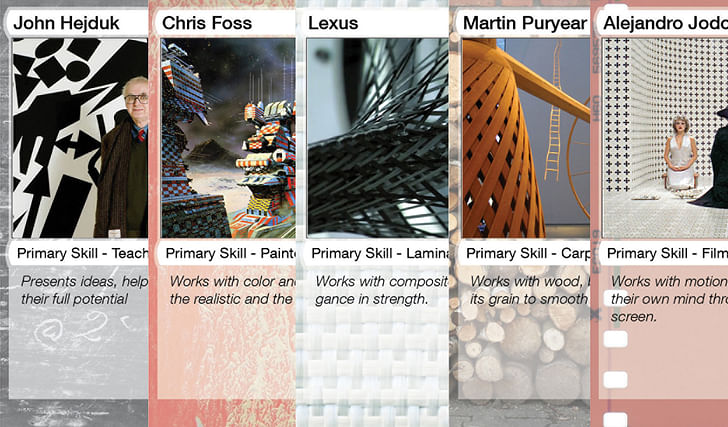

In a typical media narrative, video games are responsible for social isolation, decreased attention spans, and even violent tendencies. But according to GamerLab™, a new educational platform and pedagogical method developed by the LA-based RotoLab, as well as an increasingly large body of research, games can offer major benefits for education, particularly when it comes to architecture.
Games aren’t just fun, they also help students develop skills and incentivize work. “Games, like our brains, operate off of incentivized, reward based challenges or a chance to ‘level up’ in achievement,” RotoLab co-founders Michael Rotondi, Nels Long and Dr. M A Greenstein write in a paper about GamerLab™ submitted to MIT's Learning International Networks Consortium (LINC) 2016 Conference. “Rewards matter, especially to ensure further pursuit of a challenging trajectory towards a goal. Rich in reward dynamics, games engage viewers precisely because they offer immediate feedback.”
GamerLab™ is working to leverage the benefits of video games, as well as emerging technologies like Virtual Reality (VR), to revolutionize the way architecture students learn. GamerLab™ signals a paradigmatic shift into new pedagogic methods and research questionsFor one, they believe that through techniques of “gamification”, or the application of elements of gameplay to other activities, students can be more invested in their projects. Rather than orienting work entirely towards end-of-term projects and grades, teachers can create a series of compelling incentives that have less intense ramifications on a student’s future.
“GamerLab™ signals a paradigmatic shift into new pedagogic methods and research questions regarding how we teach innovative courses to enhance collaboration skill sets, research skill sets and design skill sets,” they write. In particular, they envision their project as an alternative to the typical pedagogical trend towards fashionable schools of thought. In this regard, they note the increasing “ossification” of parametricism and object oriented ontology (OOO) as the dominant paradigms to understand the implications of new technologies and network culture on architecture.
“As evidenced in today’s reigning architectural schools SCI-Arc and the Architectural Association School of Architecture, curriculum designers of OOO and parametric approaches tend to theorize away the privileged human dimension in object making, making room instead for robotic or metric driven design,” they write. “The consequence? Digital natives are kept in the dark regarding emergent theories in gaming and neuroscience that shed light on empowering first person, spatial perception perspectives deemed useful even in a design age that has begun to question the role of the ‘starchitect’.”
GamerLab™ centers the use of avatars, or pseudonymous online personas, as a major new tool to be unleashed in architectural pedagogy. By having students take on a false persona, they have less anxieties about the implications of risk-taking for their future.What proved profitable for guilds in late Middle Age, now loses social caché for digital natives Freed from this weight, students can engage in more creative pursuits. “Suited up in an avatar identity, the otherwise timid or introverted student can bypass attempts to make up pseudo architectural theory or worse, parrot a mentor’s point of view.”
GamerLab™ also believe that such strategies can help dismantle traditional power dynamics within the academy and the profession. “We envision the potential of gamified education mechanics upending the centuries of design education practice especially old master/apprentice relationships,” they write. “What proved profitable for guilds in late Middle Age, now loses social caché for digital natives who do not presume subjective connoisseurship nor the passing of power down to a mentee or protégé.”
Alongside avatars, storytelling serves as a technique for opening up new potential relationships to education. A compelling story, like those in video games, keeps a student interested in the project. Moreover, within a constructed narrative, students wouldn’t be relating their work to themselves, but rather to the character they inhabit and the world the character occupies.
Another research interest of GamerLab™ is VR technology. They are pioneering new modes of architectural visualization that allow for interactive relationships with models. Rather than relying on traditional techniques of architectural representation, VR enables students to virtually inhabit the spaces that they design. “It is time for a new generation to strap on their headsets and enter new non-Euclidean worlds waiting to be imagined, rendered and gamified for interactive response!”Passion and play are what we sorely need if design education is going to meet the architectural, urban and product demands of changing technologies
By harnessing the structure of the internet, architects can collaborate regardless of geographic distance. Students, feasibly, wouldn’t have to enroll in expensive schools in order to gain an education. Instead, they could strap on a headset and collaborate with like-minded practitioners around the world in so-called “affinity spaces”.
"Passion and play are what we sorely need if design education is going to meet the architectural, urban and product demands of changing technologies available 24/7 on the Web,” GamerLab™ writes. “It is with the fullness of heart and mind that we propose GamerLab™ as a galvanizing force of change within higher education.”
Want to hear more about what GamerLab™ is up to? Listen to our conversation with them on Archinect Sessions: One-to-One!
Writer and fake architect, among other feints. Principal at Adjustments Agency. Co-founder of Encyclopedia Inc. Get in touch: nicholas@archinect.com
2 Comments
There are some great ideas in this venture. I hope to see them grow.
def. listening to this weekend, very interesting and the RotoLab looks awesome, especially the competition and all the worlds it is in connection with
above text by Nicholas reminds me very much of me watching my 8 year old daughter build a theme park in some custom game on Roblox. Earning money, expanding zones and types of rides based on Human Avatars and Artificial Avatar interaction.... Sometimes that is the only time I get to see what all (and I mean a lot) goes on in her head.
Block this user
Are you sure you want to block this user and hide all related comments throughout the site?
Archinect
This is your first comment on Archinect. Your comment will be visible once approved.